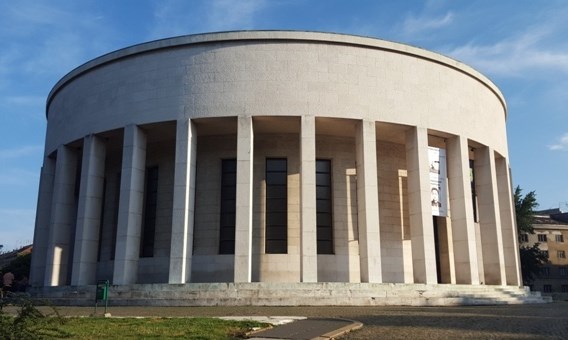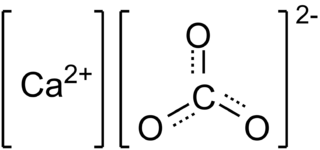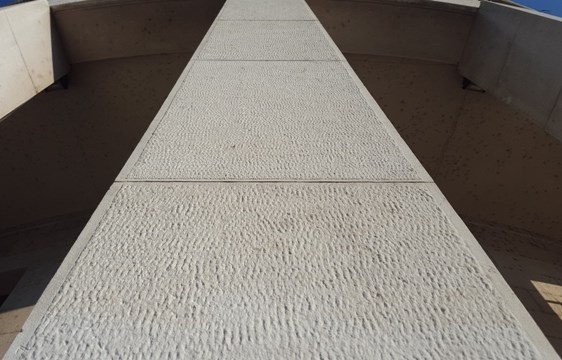
This EarthCache brings you to the monumental, round building that was built in 1938 and designed by well-known Croatian sculptor Ivan Mestrovic. The entire building is built from autochthonous white rock quarried at Veselje quarry on Croatian island of Brac. This white rock is wonderful example of limestone, or to be more precise wonderful example of type of limestone that is called rudist limestone.
EarthCache

Limestone
Limestone is categorized as sedimentary rock. Sedimentary rocks are one of three large groups of rocks, the other two are igneous and metamorphic. Sedimentary rocks are formed when different materials are deposited by different geological processes and accumulated either at the surface of Earth or within water. Accumulated material that form sedimentary rocks is called sediment.
Limestone is sedimentary rock that is mainly (more than 50%) built from calcium carbonate (CaCO3), particularly from its two crystal forms - calcite and aragonite.
CaCO3
 Source: Wikipedia
Source: Wikipedia
Majority of limestone rocks form in shallow, calm and warm marine waters. Limestone rocks represents 10% of all sedimentary rocks. There are different types of limestone and they can be formed by various processes. In general, if limestone is formed from calcium carbonate that came from various marine organisms (e.g. corals, forams, molluscs) then it is called biological limestone. Its biological origins could often be detected by the presence of fossils. Limestone can also be formed by direct precipitation of minerals from water and such limestone is called chemical limestone.
Rudists
Rudists are a group of marine molluscs with two shells or valves (bivalves) that existed from the Late Jurassic to the Late Cretaceous periods. Their valves were unequal and one of them were attached to the sea floor. They resided in shallow, calm and warm marine waters. During the time of dinosaurs reefs were mainly built by rudists, not by corals. They went extinct at the end of the Cretaceous period during the Cretaceous–Paleogene extinction event, the same mass extinction event that wiped out dinosaurs.
Rudists
 Source: James L. Wilson, (1975), Geologic History in Carbonate Facies, New York: Springer.
Source: James L. Wilson, (1975), Geologic History in Carbonate Facies, New York: Springer.
Rudist Limestone
The main source of calcium carbonate in rudist limestone are rudist shells. Rudists, as well as many other marine organisms, developed the ability to use calcium carbonate from marine water and to build their protective shells from that material. When these organisms died, their shells (built from calcium carbonate) were accumulated on the seafloor. Those shell sediments over many years of accumulation are transformed into sedimentary rock limestone by binding initial rudist shell material together with chemically precipitated calcium carbonate cement.
Rudist fossils are often found in these rocks. Rudist limestone specimens on the ground zero were formed during Late Cretaceous period (i.e. 100.5 to 66 million years ago) and you can find some examples of rudist fossils in rocks used on building columns.
Rudist Limestone

Fossils
On EarthCache location, you can find not only nice example of sedimentary rock limestone, but also nice examples of fossils. What are fossils, anyway? Well, they are anything that provides evidence of life in past ages. That evidence of life in past ages can come in two types. It can be either direct evidence or indirect evidence of past life.
Direct evidence of life are fossils of hard body parts of organisms. They can be fossilized bones or shells in case of animals. Or it can be fossilized wood or leaves in case of plants. In some cases, the entire organism can be fossilized, together with both soft and hard parts. Example of such fossils are insects trapped in amber or mammoths frozen in ice.
Indirect evidence of life are trace fossils. They are various footprints, trails, marks that were left by organisms and then fossilized. Coprolites (fossilized poo) is also one example of trace fossils. Another example of trace fossils are chemical fossils that represent organic compounds that survive in the form of oil, gas or bitumen.
Logging Tasks
To log this EarthCache answer the following questions:
1. Explain how rudist limestone from the EarthCache location was formed.
2. Is this limestone biological or chemical limestone? Why?
3. Search the building columns and find at least one fossil of rudist. Describe the fossil and report its measures.
4. Based on your observation of fossil, what do you think: is this fossil direct evidence or indirect evidence of past life? Why?
You must send the answers to me through my profile at geocaching.com and NOT in a log. You don't have to wait for me to approve your answers. Once you send your answers feel free to log the cache as found. If your answers are wrong, I will contact you.
Sources
1. Fossils, Course Notes, EarthCache Academy.
2. James L. Wilson, Geologic History in Carbonate Facies, New York: Springer, 1975.
3. Zagrebackim ulicama... Zagreb u kamenu, Zagreb: Croatian Natural History Museum, 2014.
4. Geology.com
5. Wikipedia.org

Ovaj EarthCache Vas dovodi do monumentalne, okrugle zgrade koja je izgrađena 1938. godine i koju je dizajnirao poznati hrvatski kipar Ivan Mestrović. Cijela zgrada je izgrađena od autohtonog bijelog kamena iz bračkog kamenoloma Veselje. Ovaj bijeli kamen je prekrasan primjer vapnenca ili preciznije prekrasan primjer vrste vapnenca koji se naziva rudistni vapnenac.
EarthCache

Vapnenac
Vapnenac se kategorizira kao sedimentna stijena. Sedimentne stijene su jedna od tri velike skupine stijena. Druge dvije skupine su magmatske i metamorfne stijene. Sedimentne stijene nastaju kada se različiti materijali talože različitim geološkim procesima. Navedeni materijali se akumuliraju ili na površini Zemlje ili u vodi. Akumulirani materijal od kojega se stvaraju sedimentne stijene naziva se sediment.
Vapnenac je sedimentna stijena koja je uglavnom (više od 50%) građena od kalcijevog karbonata (CaCO3) i to konkretno od njegova dva kristalna oblika - kalcita i aragonita.
CaCO3
 Izvor: Wikipedia
Izvor: Wikipedia
Većina vapnenačkih stijena nastaje u plitkim, mirnim i toplim morima. Vapnenac čini oko 10% svih sedimentnih stijena. Postoje različite vrste vapnenaca koji mogu nastati različitim procesima. Općenito, ako je vapnenac nastao od kalcijevog karbonata koji potiče od različitih morskih organizama (npr. koralja, krednjaka, mekušaca) tada se takav vapnenac naziva biološki vapnenac. Biološko porijeklo takvog vapnenca se često može detektirati na temelju prisutnosti fosila. Vapnenac također može nastati direktnim taloženjem minerala iz vode. Takav vapnenac se naziva kemijski vapnenac.
Rudisti
Rudisti su grupa morskih mekušaca s dvije školjke ili ljušture (bivalve) koja je postojala od perioda Gornje Jure do Gornje Krede. Njihove školjke su bile nejednake i jedna od njih je bila pričvršćena za morsko dno. Prebivali su u plitkim, mirnim i toplim morskim područjima. Tijekom vremena dinosaura grebeni su uglavnom bili građeni od rudista, a ne od koralja. Izumrli su na kraju perioda Krede tijekom Kredsko-tercijarskog masovnog izumiranja, istog masovnog izumiranja tijekom kojega su izumrli i dinosauri.
Rudisti
 Izvor: James L. Wilson, (1975), Geologic History in Carbonate Facies, New York: Springer.
Izvor: James L. Wilson, (1975), Geologic History in Carbonate Facies, New York: Springer.
Rudistni vapnenac
Glavni izvor kalcijevog karbonata u rudistnom vapnencu su školjke rudista. Rudisti su, kao i mnogi drugi morski organizmi, razvili sposobnost iskorištavanja kalcijevog karbonata iz morske vode kako bi od tog materijala izgradili zaštitne oklope. Kada su ovi organizmi uginuli, njihove su se školjke (izgrađene od kalcijevog karbonata) akumulirale na morskom dnu. Tijekom mnogih godina ovi su se sedimenti školjaka transformirali u sedimentnu stijenu vapnenca povezujući inicijalni materijal rudistnih školjki zajedno s kemijski taloženim cementom kalcijevog karbonata.
Fosili rudista se često nalaze u ovom kamenju. Primjerci rudistnog vapnenca na lokaciji ovog EarthCachea formirani su tijekom perioda Gornje Krede (tj. prije 100,5 i 66 milijuna godina), a neke primjerke fosila rudista možete pronaći u kamenju od kojega su izgradjeni stupovi ove zgrade.
Rudistni vapnenac

Fosili
Na lokaciji EarthCachea, pronaći ćete ne samo lijep primjer sedimentne stijene vapnenca, vec i krasne primjere fosila. No, što su uopće fosili? Pa, oni su zapravo sve ono što dokazuje život u prošlim vremenima. Taj se dokaz proslog života javlja u dva oblika. On može biti izravan ili neizravan.
Izravan dokaz života su fosili koje čine čvrsti dijelovi organizama. U slučaju životinja, to mogu biti fosilizirane kosti ili školjke. Ili, kada su u pitanju biljke, to može biti fosilizirano drvo ili lišće. U nekim slučajevima fosiliziran može biti i cijeli organizam, i njegovi meki i njegovi čvrsti dijelovi. Primjeri takvih fosila su insekti zarobljeni u jantaru ili mamuti smrznuti u ledu.
Neizravan dokaz života su fosilni tragovi. To su različiti otisci stopala, repova, tragova, koje su organizmi ostavljali, a zatim su fosilizirani. Koproliti (fosilizirana kakica) su također jedan primjer fosilnih tragova. Još jedan primjer fosilnih tragova predstavljaju i kemijski fosili. Kemijski fosili su organski spojevi koji su se očuvali u obliku nafte, plina ili bitumena.
Zadaci za logiranje
Kako biste logirali ovaj EarthCache odgovorite na sljedeća pitanja:
1. Objasnite kako je nastao rudistni vapnenac koji se nalazi na lokaciji EarthCachea.
2. Je li ovaj vapnenac biološki ili kemijski vapnenac? Zašto?
3. Pretražite stupove zgrade i pronađite bar jedan fosil rudista. Opišite pronađeni fosil i izvjestite o njegovim mjerama.
4. Na temelju Vašeg promatranja fosila, što mislite: je li ovaj fosil direktan ili indirektan dokaz o prošlom životu? Zašto?
Odgovore pošaljite preko mog profila na geocaching.com, a NE u Vašem logu! Ne morate čekati na moje potvrđivanje Vaših odgovora. Jednom kada pošaljete Vaše odgovore slobodno logirajte pronalazak ovog EarthCachea. Ako Vaši odgovori budu pogrešni ja ću kontaktirati Vas.
Izvori
1. Fossils, Course Notes, EarthCache Academy.
2. James L. Wilson, Geologic History in Carbonate Facies, New York: Springer, 1975.
3. Zagrebačkim ulicama... Zagreb u kamenu, Zagreb: Hrvatski prirodoslovni muzej, 2014.
4. Geology.com
5. Wikipedia.org